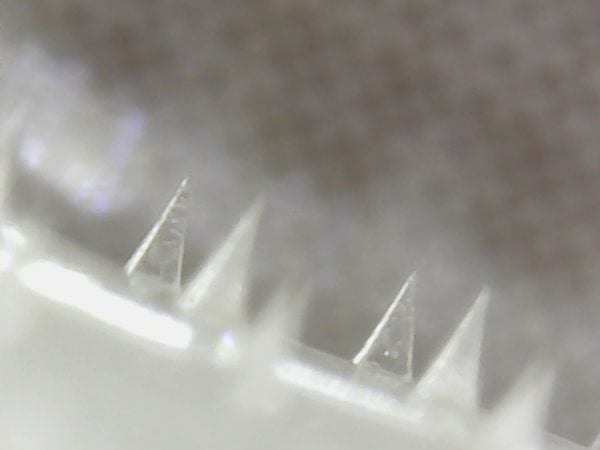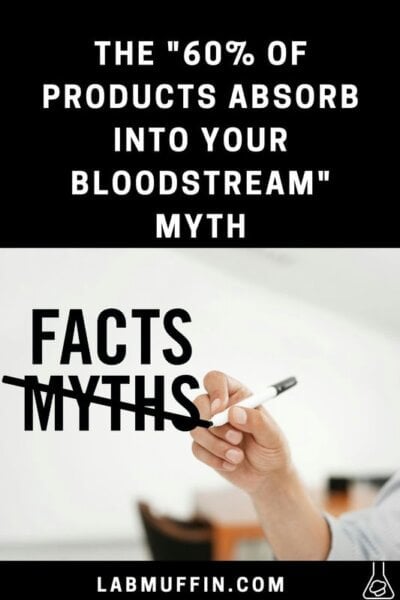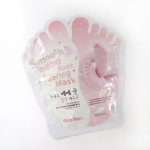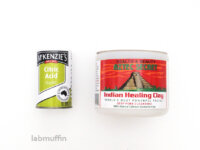The myth that “60% of what’s applied to your skin is absorbed into your bloodstream” is one of my pet peeves. It’s so far from the truth, and it’s cited with such an air of authority that it really ticks me off.
It also tends to be cited by the sorts of people who push “non-toxic” products, which is very much a BS marketing tactic.
Let’s break down how human skin works, and why this myth is just plain wrong.
The video is here on YouTube, keep scrolling for the written version…

Skin is not a sponge
One of your skin’s main functions is to act as a barrier – that is, it blocks substances from getting into the deeper living layers of your body.
If things were so easily absorbed into skin, humans would’ve died a long time ago (probably from exploding after absorbing a tree or something). Thank you, evolution!

So by default, the amount of substances absorbed is going to be closer to 0% than 100%.
You can see this in everyday life as well:
- You don’t get massively heavier after you take a bath.
- You don’t absorb your clothes.
- You still have make-up to remove at the end of the day.
- You can’t just slap food you don’t like on your skin to get around eating it.
Medicated creams and patches
At this point in my rant, people who promote the 60% absorption myth like to bring up medicated creams and patches. If skin’s such a great barrier, they say, why do medicated creams and patches work?
(They smile smugly as I take a sip of water. “Got her!” they think. But they’ve made a huge mistake. Medicinal chemistry is MY home turf.)
Transdermal medications have a few advantages.
One of the biggest headaches in designing medications is first pass metabolism, which is when your digestive system metabolises and gets rid of oral medications before they get absorbed into your bloodstream.
To compensate for this, you have to take a lot more of the medication so that enough of it makes it to your bloodstream to have an effect. Alternatively, you can avoid the digestive system altogether with IV drips, injections, suppositories etc. – or transdermal delivery.
Transdermal products can be designed to release the drug more slowly and consistently than other methods. They’re also easier to administer to uncooperative patients.
But while transdermal medications sound great, it actually takes a lot of effort to get drugs through your skin and into your bloodstream.
Compared to the total number of medications on the market, the number of transdermal medications are extremely limited, and lots of formulating tricks are used to get them through the skin.
Take transdermal patches, like nicotine patches – as well as lots of penetration enhancers that help the nicotine get through skin, they also need a liner to protect the ingredients from rubbing off.
Even with all this intentional effort and design, there’s still 10-95% of the drug remaining on the surface of the skin with the transdermal drug products currently on the market.
Absorption depends on a lot of different things
So why do some things get through skin into the bloodstream? If skin is such a good barrier, does that mean skincare doesn’t work?
Well, how much of a substance absorbs into skin depends on a ton of things (which is why the blanket statement of 60% rings alarm bells for us pharma nerds).
What is it?
How well a substance gets through your skin into the blood depends on the structure of the substance itself.
Firstly, molecular size is important. The smaller the molecule, the more easily it squeezes in between all the substances already in your skin, sort of like how you try to make yourself as small as possible to get through a crowd.

Your skin is also both watery and oily at the same time, and things that dissolve in water tend not to dissolve in oil.
It has to have the right balance of hydrophilic and lipophilic (the right polarity) to get into the skin, then leave the skin and enter the blood.

As you’d expect, drugs that can be delivered transdermally tick these boxes – but most drugs don’t, and it’s the same for other substances that encounter your skin.
Where are you putting it?
Your skin doesn’t have the same permeability all over, so skin absorption depends on the location of application.
For example, here’s a table (from this book) showing the permeabilities of hydrocortisone and two pesticides through skin in different locations.
| Anatomical region | Dose absorbed (%) hydrocortisone | Dose absorbed (%) parathion | Dose absorbed (%) malathion |
|---|---|---|---|
| Forearm | 1.0 | 8.6 | 6.8 |
| Palm | 0.8 | 11.8 | 5.8 |
| Foot, ball | 0.2 | 13.5 | 6.8 |
| Abdomen | 1.3 | 18.5 | 9.4 |
| Hand, dorsum | - | 21.0 | 12.5 |
| Forehead | 7.6 | 36.3 | 23.2 |
| Axilla | 3.1 | 64.0 | 28.7 |
| Jaw angle | 12.2 | 33.9 | 69.9 |
| Fossal cubitalis | - | 28.4 | |
| Scalp | 4.4 | 32.1 | |
| Ear canal | - | 46.6 | |
| Scrotum | 36.2 | 101.6 |
You can see that the different substances have different permeabilities, and you can see some areas are better at absorbing things (armpit (axilla), jaw angle, ear canal and, uh, scrotum…
I’m assuming the additional 101.6% for parathion is experimental error), while others are pretty impermeable (foot, palm, forearm).
Note that this table only shows percutaneous absorption – in other words, absorption through the skin.
Getting through the skin doesn’t necessarily mean that the substance ends up in the blood, since not all locations have the same blood flow, and the blood vessels are at different depths, so the actual amounts of these substances that get to the blood are much lower.
What are you putting it on with? How are you applying it?
There are some other things you can do with an ingredient to enhance how well it absorbs into skin. Transdermal patches and creams exploit a few of these.
For example, occlusion (covering up your skin) will help underlying substances penetrate the skin.
A lot of medicated creams and skincare products also include penetration enhancers. These ingredients help substances absorb better.
Some of them will make the stratum corneum (the dead outer layer of your skin) more fluid, others will disrupt the proteins and oils on your skin, or hydrate your skin. Penetration-enhancing ingredients include alcohols, essential oils, fatty acids, urea and just plain water.
You can also use tools to increase penetration, like ultrasound, electroporation, iontophoresis, heating and microneedles. Depending on the technique, these drive the ingredients into the skin or disrupt the skin barrier.
Related post: Ion Boosted Skincare? Panasonic Skincare Tools (video)

But in your standard beauty products, you rarely have many of these special tricks in place. In fact, some products are specially formulated to stay on top of your skin.
Sunscreens, for example, are designed to sit in a layer on top of your skin, since they’re useless if it’s under your skin.
Related post: Sunscreens in your blood??! That FDA study
Does this mean skincare doesn’t work?
So if skin is such a good barrier, does that mean skincare won’t absorb and therefore won’t work? Luckily for us skincare enthusiasts, not necessarily!
Skincare is for skin, not blood
As previously mentioned, most things that do get absorbed into your skin don’t make it past the first few layers of the dead stratum corneum. Even less make it through the epidermis to the deeper dermis, where your blood vessels are.
But for skincare, that’s fine – you want generally want it in to stay in the top layers of your skin where you apply it! Moisturisers are meant to work to hydrate the stratum corneum, and most actives work in the epidermis.
Ingredient selection
Most of the active ingredients used in skincare, like ascorbic acid and tretinoin, are small enough to penetrate into skin.
Larger ingredients like collagen, hyaluronic acid, petrolatum and sunscreens work at the surface of the skin, so they don’t need to penetrate.
Formulations can help ingredients penetrate
Skincare products can be purposely formulated so the ingredients have the best chance of penetrating through the dead stratum corneum into the living layers of the skin.
The most common method is the use of penetration enhancers. The same ingredients used in transdermal medications show up in skincare as well – that’s one of the reasons why denatured alcohol is in a lot of products.
Another factor is pH. If there’s an acidic ingredient, a low pH will generally help it penetrate skin, while higher pH usually makes it too polar (water-soluble).
Related post: Why pH matters for AHAs and acids in skincare (video)
There are some less commonly used strategies as well, like liposomal delivery – but these aren’t common in skincare products.
Verdict
There are a few freak things that absorb 60% or more, but for the vast majority of ingredients and situations, 60% is a massive overestimate. Phew!
References
Pastore MN et al., Transdermal patches: history, development and pharmacology (open access), Br J Pharmacol 2015, 172, 2179-209. DOI: 10.1111/bph.13059
Alkilani AZ, McCrudden MT, Donnelly RF, Transdermal drug delivery: innovative pharmaceutical developments based on disruption of the barrier properties of the stratum corneum (open access), Pharmaceutics 2015, 7, 438-70. DOI: 10.3390/pharmaceutics7040438
FDA, Guidance for industry: residual drug in transdermal and related drug delivery systems, 2011.
Bronaugh RL & Maibach HI, Percutaneous Absorption: Drugs – Cosmetics – Mechanisms – Methodology (3rd Edition);
CRC Press: 28 May 1999.








Thank you for this science! I was particularly intrigued by the bit near the end of the article about why denatured alcohol is commonly used in skincare. I’ve recently started using Avon skin so soft oil spray that contains denatured alcohol and thought alcohol would be drying to the skin. But obviously it helps the skin absorb more of the product. Keep debunking! ?
So what are your thoughts on retinol entering the blood stream ?
YES!!! the whole stay away from any kind of retinol while pregnant because it was proven retinol taken orally is dangerous!?
I love how informative and understandable you are. Also love your indignation. Keep up the great work.
You are my hero, Michelle!
Not only do I share your frustration w/ the fear-mongering bag o’ dicks masquerading as some Borg brain-sucking hive mind, contaminating every nook & cranny of my internet; I also was in dire need of a solid post w/legit sources & language & concepts, written clearly enough that even a brain-sucking bag o’ dicks could understand it.
So, again, thank you for your expertise, your grasp of the depth of ignorance peddled online like free poison candy, & the casual genius & easy acuity you demonstrate for the subject which is, luckily for your readers, your chosen subject of mastery.
Now, I can link to this (with your permission, of course), for all those times when I’m engaged in a delightful & oh-so-mutually-enriching interaction with one of our modern day stalwart defenders of bullshit (their coat of arms being two crossed fingers {[at the end of stubby lil’ arms]} capable of clicking ferociously, no subject too goofy, hypocritical, nor completely unresearched; deperately in search of their next defense of absurdity incarnate; the foreground featuring a ginormously epic pile of steaming manure, & maybe an even larger, more steaming pile of visibly obviously stanky poo in the background; truly a masterpiece of the ages).
My coat of arms is an actual jacket that is made of just really large warm arms, all for hugging me when I am chilly.
Muchlove, as always, suki
I think the big take away here is don’t put pesticide on your genitals.
(Seriously though, thanks as always for the science.)
Ah, so good to see someone call BS on this! I was going to do it myself but you have done a stellar job of explaining the science. Good to see that others are infuriated by the direct manipulation of consumers through blatant fear mongering campaigns!
Interesting article Michelle. Thank you!
Thank you very much for this article. I personally am so annoyed with the baseless, fear-mongering, only-natural-is-good type of marketing, especially those saying “studies show blah blah blah”, without pointing to any study, or by exaggerating small inconclusive studies, or by misrepresenting proper studies. I remember reading an article written by a woman who wanted to go vegan in her skincare and cosmetics (the article was in an entertainment website). She mentioned a certain “finding” by a US government agency about how dangerous a skincare ingredient was and posted a link to the alleged finding. The link, however, was to a Safety Data Sheet on the ingredient. She obviously has no idea what an SDS is and its purpose, but used the SDS to bolster her claim that that particular ingredient was found dangerous by a government agency.
This is such an intersting post, thank you so much for sharing all this information!
I hope it’s okay if I ask a question that might be kind of stupid. I’m using a sunscreen that claims to use a liposomal technique (Cetaphil Sun Daylong), but I kind of wonder how it works and, because you mentioned in the article that sunscreen’s supposed to stay on top of your skin and not be transported into the deeper layers, is it even sensible/good for a sunscreen to use liposomal delivery? Wouldn’t that prevent the sunscreen from staying on top of your skin?
Thanks! I am rather tired of the scare mongers. You keep things real.
Such an good topic and understandable article. I’m a pharma nerd too, worked in the industry most of my adult life – naturally I love your blog! I was in an analytical lab for a few years before transitioning to clinical trials. I cringe at most statements I hear and am amazed at how many come from dermatologists!
Before pharma, I worked in a pesticide testing lab (government job, monitoring label claims) – interestingly I had CNS reactions to parathion and malathion, likely from inhalation. We handled 95-98% concentrated product to use as a standard in gas chromatography (the most sophisticated analytical instrument back then, lol, I’m old, it preceded liquid chromatography and mass spec).
Yup and them influencers quote these bad dermatologists. Wear 50+ sunscreen every day, and reapply even if you’re working from home
Thank you for writing this article!!! I am losing my patience with aestheticians on IG about this issue lmao. Also if our skin was that permeable wouldn’t we have the problem the opposite way too, eg, constantly leaking blood out of our skin?!
One of my pet peeves too. Right there with “alkaline water”! Or “don´t apply on your skin what you wouldn´t eat”.
Anne from “Doctor Anne” (former Linda, Libra, Loca)
Thank you so much for this. The influencers and bloggers will have you believing everything is absorbed into your skin, everything has to be non-toxic and buying overpriced products. I think it’s okay to buy less chemicals but not to scare people.
If the fearmongering were true, then we wouldn’t have to eat anymore. We could just rub food on our skin and then we would absorb all the nutrients directly from the skin to our bloodstream.
If the fearmongering were true, then we wouldn’t have to eat anymore. We could just rub food on our skin and then we would absorb all the nutrients directly from the skin to our bloodstream.
Thank you – great article. Can Hyaluronic Acid (serum) or Sodium Hyaluronate be absorbed into the bloodstream? I read that it may not be safe for breast cancer survivors. Would love your feedback-
Thanks so much
I really doubt it, it’s usually very high molecular weight!
So if we stuck our nicotine patches on our scrotum it’d be baller? 🤣
I know this post is specifically about skin absorption, but I wonder if we should be at all concerned about products being absorbed through the eyes? My sunscreen tends to drip in my eyes on hot days, and I’ve heard that PFAS in eye makeup can enter the body through tear ducts and build up over time. Is this another case of clean beauty fearmongering, or should we be more cautious about what we use on/around our eyes?
Your eyes aren’t one of the top routes of absorption when it comes to toxic substances (although it will depend on the specific substance) – most of the warnings about eye exposure are because eyes are fragile, and get infected easily.
Hi
Your article is not evidence based and according to several articles and experience, skin is a big absorber of stuff especially oil based substances.
Skin is increasingly used to put many medications in body; even though, it has not been standardized yet.
Please do not mislead people anymore.
Sorry, but “several articles and experience” aren’t really the same as having a PhD in medicinal chemistry. The reason it’s becoming increasingly common is because of advances in technology that can get ingredients to penetrate. If it was inherently good at absorbing everything, it would’ve been much more popular all along, skin absorption is a much nicer route of delivery than injections.
Sometimes smart people like you are so smart they miss what’s right under their nose. Everything you said would be true if you ignore cosmetic formulation science. It’s 100% about getting lipid and aqueous compounds to : treat and stay on your hair, your skin, your armpits.
As a random first try simple popular example I rcan pick any cosmetic formulation, say an “anti wrinkle skin cream”: here’s what came up first:
https://ogee.com/products/indigo-dream-renewal-cream. These “products versus your ridiculous oversimplification of cosmetic science is laughable if it were not so tragic. While we drown in complex synthetic formulations by air land and sea (skin mouth, breathing, OTC products and bad for us processed foods you spout nonsense that is relight I. The teeth of the prevailing winds killing us and you so your quality of life is over by your 60’s! I am a pharmaceutical scientist so your expertise is misleading your followers to blindly trust you falsely as far as I’m concerned.
Almost all skin products are nanoemulsions. Most are DESIGNED BY experts to GET INTO YOUR SKIN!!!!!!!
Here’s what’s in it: and this was RANDOMLY found!!!! You could Google search products all day same result.
INGREDIENTS
Aloe Barbadensis Leaf Juice*, Simmondsia Chinensis (Jojoba) Seed Oil*, Cetearyl Alcohol (from Vegetable Sources), Glycerin* (from Vegetable Sources), Lauryl Laurate, Water/ Eau/ Aqua, Ricinus Communis (Castor) Seed Oil*, Polyglyceryl-3 Stearate (from Vegetable Sources), Alcohol* (from Vegetable Sources), Glycerin (from Vegetable Sources), Cocos Nucifera (Coconut) Oil*, Inulin (from Agave, Chicory & Wild Sunflower), Sclerotium Gum (from Fungi), Vitis Vinifera (Grape) Seed Oil*, Phenethyl Alcohol (from Sugarcane), Copernicia Cerifera (Carnauba) Wax*, Raspberry Ketone, Ceramide NP (from Vegetable Sources), Sodium Levulinate (from Vegetable Sources), Citric Acid (from Corn), Acmella Oleracea (Electric Daisy) Extract, Sodium Anisate (from Vegetable Sources), Sodium Phytate (Vegetable Derived), Glyceryl Caprylate (from Vegetable Sources), Glyceryl Laurate (from Vegetable Sources), Lavandula Angustifolia (Lavender) Oil, Genipa Americana (Genit Tree) Fruit Extract, Tanacetum Annuum (Blue Tansy) Flower Oil, Phytosphingosine (from Fermentation), Sodium Hyaluronate (from Fermentation), Linalool**.
Just because something is *designed* to get into skin doesn’t mean it will. If you’re really a pharmaceutical scientist, you should be well aware of how difficult it is to design topical pharmaceuticals, and how just shoving something into a nanoemulsion doesn’t suddenly negate all other pharmacokinetic considerations.